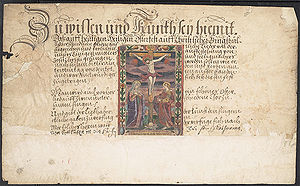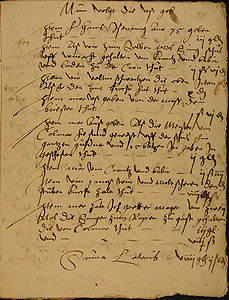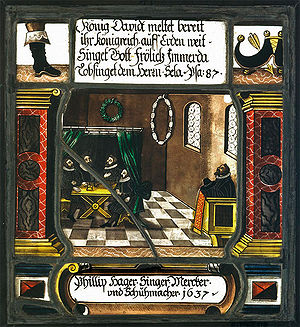
Composers of occasional poetry in urban areas in the late Middle Ages and early modern period, mostly craftsmen, who formed their own societies. Their poems, referred to as Meisterlieder, are in many respects in the tradition of the courtly "Sangspruch" poetry of the 12th-14th centuries, whose representatives the Meistersinger revered as "old masters". Craftsmen who wrote poetry for Meisterlieder have been documented since the end of the 14th century, first in Munich and Nuremberg. An institutionalisation of their meetings in the form of societies, however, is not found until the end of the 15th century. These were widespread in southern Germany, especially in imperial and mining cities, with Nuremberg playing a central role. Some societies existed until the 19th century. The Thirty Years' War (1618-1648) represented an important turning point in their history.
Definition
Meistersinger are those urban bourgeois poets of the late Middle Ages and early modern period who wrote and/or performed poetry referred to as Meisterlieder within the institutionalised framework of the organised Meistersinger societies. With their songs, the Meistersinger in many ways continued the practice of the medieval courtly "Sangspruch" poets of the 12th to 14th centuries, above all in using either self-invented or others' "tones" for the Meisterlieder (a "tone" is the accordance of melody and all the song verse's other formal features such as their rhyming pattern and verse structure). However, the Meistersinger were no longer professional poets, as the travelling Sangspruch poets predominantly were, but rather pursued a full-time profession of their own, mostly as craftsmen. Academically trained Meistersinger (clergymen, teachers, lawyers) and nobles were the exception. As a distinctly institutionalised form of literary communication, Meistergesang can be equated with comparable phenomena from the rest of late medieval and early modern Europe, for example the Dutch Rederijker as well as northern and southern French and Spanish singing or "literature" societies, despite numerous differences in detail.
The fact that, in addition to the institutionalised Meistergesang documented since the end of the 15th century, professional writers also wrote poems in the tradition of the Middle High German Sangspruch poets without any connection to the organised Meistersinger societies until the 16th century has long led to confusion with the terminology. Nowadays, we speak of "meisterliche Lieddichter" and then differentiate between professional master singers and amateurs.
Beginnings
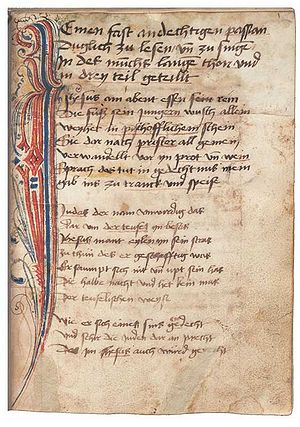
In the time before Meistersang was institutionalised, amateur Meistersingers resident in the city can be found solely in Nuremberg (and they are partly documented there in archives). The earliest here include the mercenary Fritz Kettner (1392-1430), the master baker Michel Nachtigall (rec.1414-1427), a Hans Bogner (rec. c. 1427-1450), the master nail maker Fritz Zorn (rec. 1427-1447), the master baker Konrad Nachtigall (rec. c. 1436-1484/85) and the master tinsmith Kunz Vogelsang (1436-1447). Whether their poetic production can be regarded as representative of the early urban Meistergesang before its institutionalisation in their own singer societies is not only questionable because of a lack of possible comparisons, but also because the widespread habit of the early Nuremberg Meistersinger to use self-invented tones for their songs can not be taken for granted even in Nuremberg. The most famous of the early Nuremberg Meistersinger, Hans Folz, finds it necessary, for example, to promote the use of self-created tones in a song cycle. Anyone who "sets" their songs in others' tones, however, often uses the highly respected ones from the "old masters", meaning the Sangspruch poets of the 13th and early 14th centuries whomst the Meistersinger revered.
The fundamental prerequisite for urban poets taking over this genre, which was carried by the travelling Sangspruch poets and had a courtly character, was this old "art" becoming increasingly less attractive at court. This process, which already began in the 14th century, can barely be reconstructed in detail. The handwritten tradition, however, indicates it quite clearly. Expensive collections of songs with a representative, noble background were hardly created anymore from the middle of the 14th century onwards(e.g. ' Manessische Liederhandschrift' C, ' Jenaer Liederhandschrift ' J). Collections of texts from so-called Meisterlieder manuscripts start to appear again on a broader scope and in a significantly altered form after a three quarters of a century-long "gap" in the tradition.
Origin and spread of the Meistersinger Societies
The coming together of Meistersinger in their own societies can be recorded with certainty since the end of the 15th, early 16th century, at first in the southwest of Germany:
| Place | Recorded | Prominent representatives |
|---|---|---|
| Nuremberg | Pre-1496 | Among others Hans Sachs (1494-1576), Benedikt von Watt (rec. 1591-1614), Ambrosius Metzger (c. 1573-1632) |
| Ulm | 1517 | Among others Johann Baur (died 1658), Hans Michael Gayßer, Johann Faulhaber (1580-1635) |
| Donauwörth | 1st quarter of the 16th century | |
| Nördlingen | 1st quarter of the 16th century | |
| Augsburg | 1534 | Among others Johannes Spreng (1524-1601), Sebastian Wild (1547-1583), Onoferus Schwartzenbach (died 1574) |
| Memmingen | c. 1600 |
The Meistersinger can also be found in the southwest of the Holy Roman Empire early on:
| Place | Recorded | Prominent representatives |
|---|---|---|
| Strasbourg | End of the 15th century | Wolfhart Spangenberg (c. 1567-1636) |
| Freiburg im Breisgau | 1513 | No songs preserved |
| Kolmar | 1549 | Among others Jörg Wickram (c. 1505-1560) |
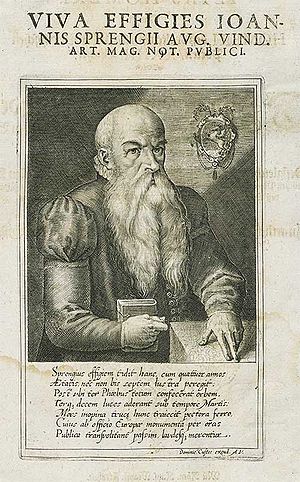
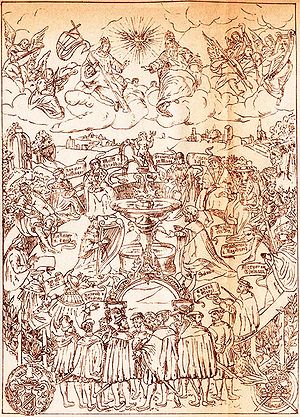
In the further course of the 16th century, foundations followed in Austria (Schwaz:: 1536, Steyr: 2nd quarter of the 16th century), in the west (Mainz: 1562) and in the east Iglau (1571) and Breslau (1598). Also to be included are other places where societies were only more or less likely to exist, but are -in any case- not documented by archives (southeast: Dinkelsbühl, Esslingen, Kempten, Munich, Regensburg, Rothenburg ob der Tauber; southwest: Wissembourg; Central Germany: Frankfurt am Main, Magdeburg, Zwickau; Austria: Eferding, Eisenerz, Wels; Bohemia/Silesia: Brieg, Mährisch-Schönberg). The Meistergesang was not popular in the north of Germany, so far without there being a convincing explanation why this was. The same applies to the striking dominance of imperial and mining cities compared to other types of cities (episcopal cities, residence cities).
The last society to be founded was also the longest lasting: the Memmingen Society of 1600 existed until 1875, at least on paper. The Ulm Society had been dissolved a few decades earlier (1839). Several associations were already abandoned in the 18th century (Augsburg: 1772; Nuremberg: 1778; Strasbourg 1780), most of them already in the 17th century (Iglau: 1620; Schwaz and Steyer: 1st quarter of the century, Nördlingen: 1st half of the century) or even in the 16th century (Freiburg im Breisgau: 4th quarter of the century; Kolmar: 2nd half of the century, Mainz: 1600). The Thirty Years' War represented an important break in social life everywhere. Later dissolutions were always preceded by a longer period of clearly decreasing activity by the members.
The Nuremberg Society played a leading role all throughout its existence, particularly with its member Hans Sachs, who was already prominent among his contemporaries. In other places, the establishment and expansion often very much relied on the commitment of one individual Georg Wickram [c. 1505-c. 1562]; Breslau: Adam Puschman [c. 1531/32-1600]).
The sociologically conspicuous fact that craftsmen are widely used as carriers of this tradition can only be explained within the broader horizon of the whole literary situation in the late medieval city. In particular, the overall picture of the existing and increasingly expanding possibilities that were available to the various social groups for "literary" communication in the late Middle Ages must be taken into account. With their "art" -particularly legitimised due to its age and origin-,the Meistersinger were offered a relatively easy opportunity to produce their own texts (these were to a large extent bound to oral communication among those present and almost exclusively distributed by hand, significantly less often in printed form) , which gave them the opportunity to practice reading and writing, and to absorb and disseminate practically relevant factual and theological knowledge. This served not the least as a way for them to gain specifically "literary" prestige within their group.
Organisation of the "Singschule" (singing school)
The Meistersingers' song production was aimed at performing the song in the "Gemerk". In these partly public, partly in-house events (in contemporary terminology "Singschule", where a distinction is made in Nuremberg between "Freisingen" (open singing), "Hauptsingen" (main singing) and "Zechsingen" (singing in taverns); other societies usually do not achieve such a degree of differentiation), the singers competed with each other in a sociable contest for an advertised prize. The minimum requirement for contributing could be as little as the presentation of an adopted text in an adopted tone.
-
Engraving of St. Catherine's Convent in Nuremberg by Christoph Melchior Roth (1720-1798). After the Reformation, the former Dominican convent served as a meeting place for the Nuremberg Meistersinger from 1620 onwards. Fig. from: Hugo Barbeck, Alt-Nürnberg, Kulturgeschichtliche Bilder aus Nürnbergs Vergangenheit. Volume 10, Churches and Chapels, sheet 14. (Bayerische Staatsbibliothek, 2 Bavar. 32 v-6/10)
-
Engraving of St. Martha's Church in Nuremberg by Christoph Melchior Roth (1720-1798). After the Reformation, the former pilgrimage church served as a performance space for the Nuremberg Meistersinger from 1614 onwards. Fig. from: Hugo Barbeck, Alt-Nürnberg, Kulturgeschichtliche Bilder aus Nürnbergs Vergangenheit. Volume 10, Churches and Chapels, sheet 15. (Bayerische Staatsbibliothek, 2 Bavar. 32 v-6/10)
The winner was usually determined by four well-recognised members on the basis of written instructions, the so-called tablatures. Contrary to a widespread misconception, these tablatures did not provide discursively formulated instructions according to which Meisterlieder could be written, but merely described types of errors and determined their severity. The tablatures are therefore an expression of a tendency towards restrictive poetics, which also fits in with the principle of the genre - adopted from the older Sangspruch poetry - of being able to reuse a given Sangspruch tone (invented by oneself or adopted from another "Meister") and to fit new texts into it. Even if the tone was the librettist's creation, sophisticated text and tone congruence could only be expected in the very first text, but merely to a limited extent for all later renditions. The basic idea honoured in the Gemerk therefore wasto fit into the given specifications in the right way -without excluding individual creative freedom.
In addition to the tablatures, "Singschul" protocols provide an insight into the organisation of the concerts, which have been preserved in Nuremberg and Augsburg, among others. The public concerts were announced by postings ("Postenbriefe"). The performance location could be marked at the corresponding time by posting a plaque/picture depicting a representative, ideal self-portrayal of the society. Not only because of this, the organisation of the "Singschulen" is full of preconditions.The foundation of "societies" – each with its own statutes and implementing regulations – explicitly served this purpose, as well as getting the events approved by the municipal authorities. Other sources (on a case by case basis) provide information about the social life beyond concerts, for example the account books (list of receipts and expenditures) in Freiburg. How the society members joined or were inducted has not been systematically investigated and reflected upon; in some places fees were levied.
-
Copy of the oldest tablature of the Strasbourg Meistersinger in the so-called Kolmarer Liederhandschrift (Colmar Manuscript of Songs). (Bayerische Staatsbibliothek, Cgm 4997, fol. 17r [Addendum]))
-
17th century Postenbrief with the announcement of a singing school in Nuremberg. (Herzogin Anna Amalia Bibliothek - Duchess Anna Amalia Library, Fol 421, p. 3)
-
List of the Colmar Society's expenses in connection with a singing school held at Christmas, among other things. (Stadtarchiv Freiburg - Freiburg Municipal Archive, Aktenbestand C1 Meistersinger 1 no. 6, sheet 20r)
Meisterlieder
The songs were intended for vocal performance and were written in Sangspruch or Meisterlied tones which specified stanza and verse structures and the melody. They had several stanzas at an odd number, with a minimum of three stanzas. The stanzas follow the bar form pattern (AAB) with two "Stollen" in the "Aufgesang" (A) and the "Abgesang" (B).
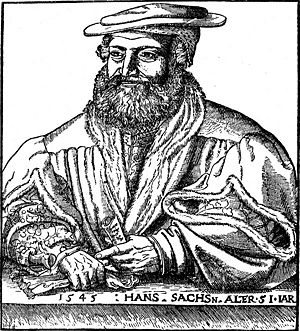
In terms of content, the Meisterlieder, of which more than 12,000 have survived, dealt primarily with religious themes, with the focus on the versification of the Bible, especially after the Reformation- after which Hans Sachs had oriented the Meistergesang. Additionally, there were poetological songs about the "art" of the "masters" themselves; besides that, secular narrative material was versified, puzzles were put into the song etc.. Only political subjects are missing completely. The most productive master was Sachs from Nuremberg with about 4,300 Meisterlieder, followed by the Nuremberg master Ambrosius Metzger with over 3,000 songs.
Sources
The handwritten literary tradition of the Meisterlieder is recorded in full in the first volume of the "Repertorium der Sangsprüche und Meisterlieder des 12. bis 18. Jahrhunderts" (RSM). The Meisterlieder texts are recorded in the newer part of the RSM (from volume 6). 15th century authors appear in the older part, however(volume 3-5). If text editions or reprints of a Meisterlied are available, they are listed in the relevant RSM articleInformation about the initially narrow, yet broadening tradition of melodies in the 15th century is also provided by the RSM volume – if the manuscripts include texts with the melodies. It is mostly the 15th century melodies (Brunner/Hartmann 2010) which have been edited, whilst later ones rarely are. A repertory comparable to the RSM, which includes relevant sources on social life beyond the Meistergesang, is a desideratum. Numerous references to the surviving school regulations, tablatures, and Singschule protocols can be found, above all, in the works by Bert Nagel (1907-2000) 1971 and Willibald Nagel (1863-1929) 1909.
Reception
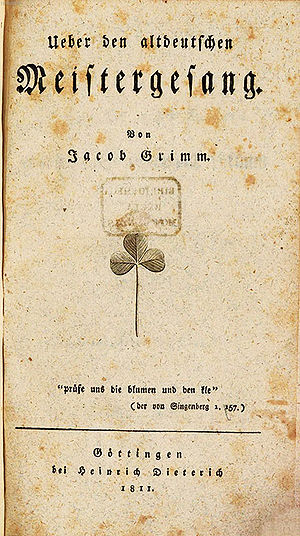
Contemporaries tended to sneer at the exclusive and traditional practice of the Meistersinger songs, who were only partly open to adapting to new literary developments. Songs in master tones, however, were also disseminated in print and in individual cases achieved considerable reach this way, such as Martin Maier´s (born 1510) "Ritter aus der Steiermark" (Knight of Styria) in the Duke-Ernst tone. Out of the few more favourable depictions, the "Buch von der Meistersinger holdseligen Kunst Anfang, Fortübung, Nutzbarkeiten und Lehrsätzen" (in: "De civitate Noribergensi commentatio", Altdorf 1697) by the Altdorf Professor for Public Law and History Johann Christoph Wagenseil (1633-1705) stands out due to its elaborate nature and relative closeness to the source material. Although the deliberations of this baroque universal scholar are of limited historical value, they went on to influence Jean Paul (1763-1825), E. T. A. Hoffmann (1776-1822) und Richard Wagner (1813-1883) (f. e. "Die Meistersinger von Nürnberg", 1868).
Hans Sachs, though, played a separaterole in the literary reception, especially among followers of the Sturm und Drang movement who even "bow to his genius" (Ferdinand Eichler, Das Nachleben des Hans Sachs, 1904, 182; cf. especially Johann Wolfgang Goethe, "Erklärung eines alten Holzschnittes, vorstellend Hans Sachsens poetische Sendung", 1776).
The scientific study of the Meistergesang started with the beginnings of German studies as a scholarly discipline (Jacob Grimm Über den altdeutschen Meistergesang, 1811, and has continued since; it was even pursued intensively in America for some time (Archer Taylor [1890-1973]). Since the late 1960s, there has been a sustained reorientation, characterised by a consistent focus on the actual, material tradition. It is closely associated with the name Horst Brunner (born 1940). The most important result of this is the "Repertorium" (RSM) completed in 2009.
Appreciation
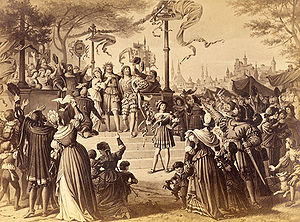
Where the Meistersinger were not despised but appreciated with regard to the quality of their song production - which was in such cases judged by ahistorical criteria - this recognition was, until the middle of the 20th century, often based on a binary perception that distinguishes between ethics and aesthetics. Aesthetically, the performances were regularly considered poor, but ethically and morally they were seen as valuable, since the art of the Meistersinger was understood to be of "sincere" and "honest" intention. The path from there to the nationalistic esteem of its typical "German" characteristic was short. It is no coincidence that Wagner's "Die Meistersinger von Nürnberg" was Adolf Hitler´s (1889-1945) favourite opera.
After 1945,scholars focused on intellectual history, have not been able to reach a clear judgement of their own. Since the late 1960s, the Meistersinger are being examined decidedly from the perspective of social and educational history. In this context it has been emphasised that previously "literature-poor" urban social classes gained their own access to literary activity for the first time through the Meistergesang, and consequentlyto areas of knowledge that had previously been almost completely inaccessible to them.
In view of comparable phenomena elsewhere in late medieval and early modern Europe, the emergence and success of Meistergesang could in future also gain particular importance from a cultural studies and media history perspective in a broader comparative framework. Namely, Meistergesang has, on the one hand, a share in the increasing spread of the written medium everywhere in early modern society and especially in its cities; on the other hand, it exemplifies the limitations of the general process of textualisation. For example, it shows a persistent and distinct "dependency on tradition" among individual social groups, especially among the learned and the ruling classes. The fact that the Meistersingers' own practice is explicitly anchored in the past, linking it back to its high and late medieval predecessors, also raises awareness of a specific problem of early modern literature: the literary precursors it invoked were, at the time, only reliably accessible to a limited extent.
References
- Michael Baldzuhn, The Companies of 'Meistergesang' in Germany, in: Arjan van Dixhoorn/Susie Speakman Sutch (Hg.), The Reach of the Republic of Letters. Literary and Learned Societies in Late Medieval and Early Modern Europe (Brill's Studies in Intellectual History 168), Leiden/Boston 2008, 219-255.
- Michael Baldzuhn, Vom Sangspruch zum Meisterlied. Untersuchungen zu einem literarischen Traditionszusammenhang auf der Grundlage der Kolmarer Liederhandschrift (Münchener Texte und Untersuchungen zur deutschen Literatur des Mittelalters 120), Tübingen 2002.
- Horst Brunner, Meistergesang, in: Klaus Weimar [u. a.] (Hg.), Reallexikon der deutschen Literaturwissenschaft. 2. Band, Berlin/New York 1997-2003, 554-557.
- Horst Brunner, Die alten Meister. Studien zu Überlieferung und Rezeption der mittelhochdeutschen Sangspruchdichter im Spätmittelalter und in der frühen Neuzeit (Münchener Texte und Untersuchungen zur deutschen Literatur des Mittelalters 54), München 1975.
- Horst Brunner, Stand und Aufgaben der Meistergesangsforschung, in: Friedhelm Brusniak/Horst Leuchtmann (Hg.), Quaestiones in musica. Festschrift für Franz Krautwurst zum 65. Geburtstag, Tutzing 1989, 33-47.
- Uta Dehnert/Senta Herkle, Die Ulmer Meistersingergesellschaft in interdisziplinärer Perspektive. Konstitution - Ordnung - Meisterlieddichtung, in: Ulm und Oberschwaben. Zeitschrift für Geschichte, Kunst und Kultur 59 (2015), 76-109.
- Reinhard Hahn, Meistergesang, Leipzig 1985.
- Robert White Linker, Music of the Minnesinger and Early Meistersinger: a Bibliography (University of North Carolina Studies in the Germanic Languages and Literatures 32), Chapel Hill 1962, unv. Nachdruck New York 1966.
- Dieter Merzbacher, Meistergesang in Nürnberg um 1600. Untersuchungen zu den Texten und Sammlungen des Benedict von Watt (1569-1616) (Nürnberger Werkstücke zur Stadt- und Landesgeschichte 39), Nürnberg 1987.
- Bert Nagel (Hg.), Der deutsche Meistersang (Wege der Forschung 148), Darmstadt 1967.
- Bert Nagel, Meistersang (Sammlung Metzler 12), Stuttgart 2. Auflage 1971.
- Johannes Rettelbach, Variation, Derivation, Imitation. Untersuchungen zu den Tönen der Sangspruchdichter und Meistersinger (Frühe Neuzeit 14), Tübingen 1993.
- Frieder Schanze, Meisterliche Liedkunst zwischen Heinrich von Mügeln und Hans Sachs (Münchener Texte und Untersuchungen zur deutschen Literatur des Mittelalters 82/83), München 1983/84.
- Eva Schumann, Stilwandel und Gestaltveränderung im Meistersang. Vergleichende Untersuchungen zur Musik der Meistersinger (Göttinger musikwissenschaftliche Arbeiten 3), Göttingen 1972.
- Irene Stahl, Die Meistersinger von Nürnberg. Archivalische Studien (Nürnberger Werkstücke zur Stadt- und Landesgeschichte 33), Nürnberg 1982.
- Archer Taylor, The Literary History of Meistergesang, New York/London 1937.
- Johannes Karl Wilhelm Willers, Hans Sachs und die Meistersinger in ihrer Zeit, Nürnberg 1981.
Sources
- Horst Brunner u. a. (Hg.), Die Schulordnung und das Gemerkbuch der Augsburger Meistersinger (Studia Augustana 1), Tübingen 1991.
- Horst Brunner/Johannes Rettelbach (Hg.), Die Töne der Meistersinger. Die Handschriften der Stadtbibliothek Nürnberg Will III. 792, 793, 794, 795, 796 (Litterae. Göppinger Beiträge zur Textgeschichte 47), Göppingen 1980.
- Horst Brunner/Karl Günther Hartmann (Hg.), Spruchsang. Die Melodien der Sangspruchdichter des 12. bis 15. Jahrhunderts (Monumenta monodica medii aevi 6), Kassel 2010.
- Horst Brunner/Burghart Wachinger (Hg.), Repertorium der Sangsprüche und Meisterlieder des 12. bis 18. Jahrhunderts, Tübingen 1986-2009.
- Eva Klesatschke/Horst Brunner (Hg.), Meisterlieder des 16. bis 18. Jahrhunderts (Frühe Neuzeit 17), Tübingen 1993.
- Archer Taylor/Frances Hankemeier Ellis, A Bibliography of Meistergesang (Indiana University Studies 23), Bloomington/Ind. 1936.
Further Resesarch
External Links
Related Articles
- Literature in Franconia (Late Middle Ages)
- Music in Altbayern (Late Middle Ages)
- Music in Suebia (Late Middle Ages)
Meistersang, Meistergesang
Cite
Michael Baldzuhn, Meistersinger, published 08 January 2018, english version published 22 June 2023; in: Historisches Lexikon Bayerns, URL: <https://www.historisches-lexikon-bayerns.de/Lexikon/EN:Meistersinger> (20.12.2025)

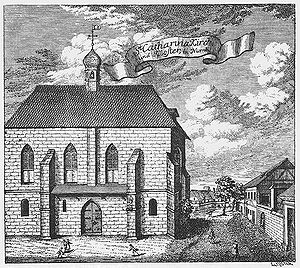
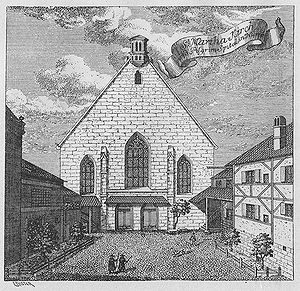
![Copy of the oldest tablature of the Strasbourg Meistersinger in the so-called Kolmarer Liederhandschrift (Colmar Manuscript of Songs). (Bayerische Staatsbibliothek, Cgm 4997, fol. 17r [Addendum]))](/images/thumb/8/8d/Artikel_45168_bilder_value_2_meistersinger2.jpg/199px-Artikel_45168_bilder_value_2_meistersinger2.jpg)
